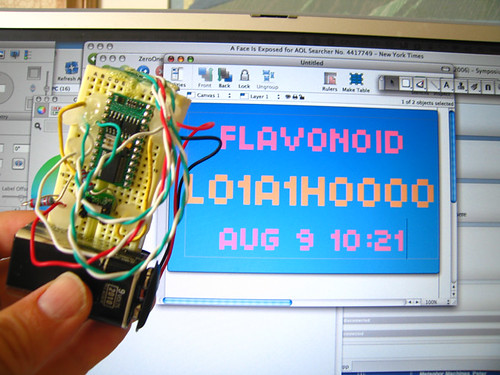I was deliriously fortunate to have been invited to spend the weekend at Foo Camp a weekend ago and equally fortunate to have met a number of hardware makers and hackers including Nathan Siedel from Spark Fun and Colin Cross, engineer by day and open cell phone developer by night.
[wikilike_img src=http://static.flickr.com/89/227229729_caf0f1d0cd_m.jpg|align=thumb tcenter|width=180|caption=Nathan Siedel, Spark Fun Electronics|url=http://www.sparkfun.com]
[wikilike_img src=http://static.flickr.com/75/227226498_7539ffa997_m.jpg|align=thumb tleft|width=180|caption=Colin Cross, Open Cell Phone Hacker|url=http://www.flickr.com/photos/julianbleecker/227226498/]
[wikilike_img src=http://static.flickr.com/64/225599650_01abe8638c_m.jpg|align=thumb tcenter|width=240|caption=Tux Phone|url=http://www.flickr.com/photos/julianbleecker/225599650/]
One of those brilliant makers is bunnie of the eponymous “bunnie studios, LLC”, who is the tech brains behind the Chumby. Chumby is a small, craft hack friendly device that plugs into the wall, and plugs into a wireless, 802.11 network. It’s got an LCD display with touch screen, a squeeze sensor, a USB port and an ARM-based processor. It runs Linux, has an Adobe Flash player — suitable for running network enabled Flash Lite content.
[wikilike_img src=http://static.flickr.com/86/228818319_d21c632668_o_d.jpg|url=http://www.flickr.com/photos/33515138@N00/228818319/in/photostream|width=500|align=thumb tcenter|caption=Chumby & Coffee]
It doesn’t require a torx wrench or rivet shears to take apart, has web-based forums dedicated to hardware and software hacking itself, has instructions for how to build your own (from schematics to a bill of materials) and has no keyboard.
These last points are why Chumby matters. Whether or not the business plan behind Chumby Studios takes hold (meaning, sustains a thorough-going commercial enterprise), the move toward open-hardware and open-source designed objects is very exciting. It’s an important progression toward empowering DIY cultures, in several senses — you can make it yours by changing it to suit your needs, sensibilities, aesthetics; you can more easily make it yours by participating amongst a community like-minded participants who may lend suggestions or advice; you share what you’ve done amongst others, an important character of communities of common interest; you don’t have to completely lock your attention to it the way you do with most typical computational and networkable devices, which require you to stare continuously at a screen and bang at keys on a keyboard.
